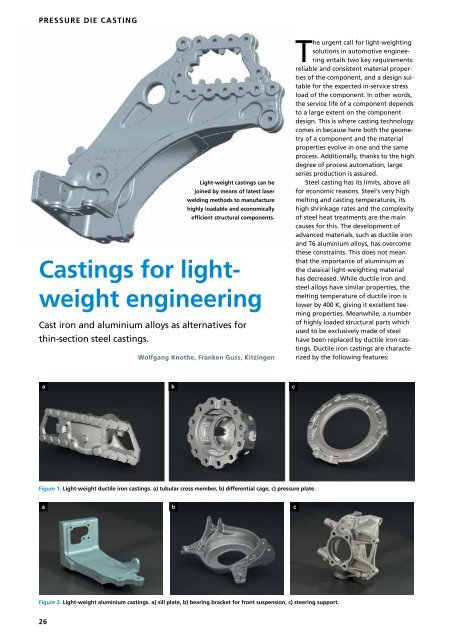CPT International 4/2019
Create successful ePaper yourself
Turn your PDF publications into a flip-book with our unique Google optimized e-Paper software.
PRESSURE DIE CASTING<br />
Photo: ??<br />
Light-weight castings can be<br />
joined by means of latest laser<br />
welding methods to manufacture<br />
highly loadable and economically<br />
efficient structural components.<br />
Castings for lightweight<br />
engineering<br />
Cast iron and aluminium alloys as alternatives for<br />
thin-section steel castings.<br />
Wolfgang Knothe, Franken Guss, Kitzingen<br />
The urgent call for light-weighting<br />
solutions in automotive engineering<br />
entails two key requirements:<br />
reliable and consistent material properties<br />
of the component, and a design suitable<br />
for the expected in-service stress<br />
load of the component. In other words,<br />
the service life of a component depends<br />
to a large extent on the component<br />
design. This is where casting technology<br />
comes in because here both the geometry<br />
of a component and the material<br />
properties evolve in one and the same<br />
process. Additionally, thanks to the high<br />
degree of process automation, large<br />
series production is assured.<br />
Steel casting has its limits, above all<br />
for economic reasons. Steel‘s very high<br />
melting and casting temperatures, its<br />
high shrinkage rates and the complexity<br />
of steel heat treatments are the main<br />
causes for this. The development of<br />
advanced materials, such as ductile iron<br />
and T6 aluminium alloys, has overcome<br />
these constraints. This does not mean<br />
that the importance of aluminium as<br />
the classical light-weighting material<br />
has decreased. While ductile iron and<br />
steel alloys have similar properties, the<br />
melting temperature of ductile iron is<br />
lower by 400 K, giving it excellent teeming<br />
properties. Meanwhile, a number<br />
of highly loaded structural parts which<br />
used to be exclusively made of steel<br />
have been replaced by ductile iron castings.<br />
Ductile iron castings are characterized<br />
by the following features:<br />
a b c<br />
Figure 1: Light-weight ductile iron castings. a) tubular cross member, b) differential cage, c) pressure plate.<br />
a b c<br />
Figure 2: Light-weight aluminium castings. a) sill plate, b) bearing bracket for front suspension, c) steering support.<br />
26

















